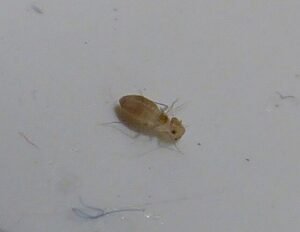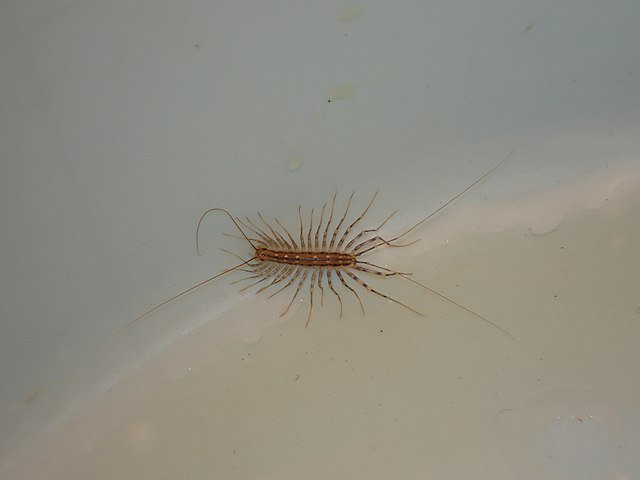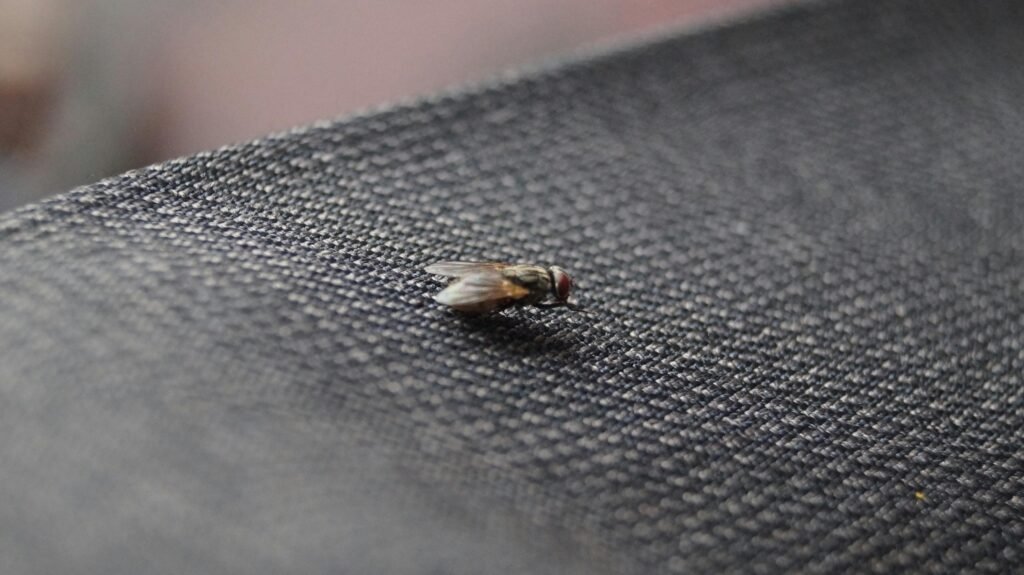Booklice (Psocids): Complete Guide

What are booklice and how do they behave? Booklice, also called psocids, are among the most common tiny insects found inside houses. They are very small, usually only 1 or 2 millimeters long, and most people notice them as tiny moving dots on walls, cupboards, or window frames. Even though the name suggests lice, they are not related. They do not live on people or pets and they never bite.
Most indoor booklice are wingless, so they do not fly. They move by crawling quickly across surfaces. They also do not jump like fleas. Outdoors some species may have wings, but inside homes the ones you see only run.
They survive by eating mold, fungi, and other microscopic organic material that grows in damp conditions. That is why they appear on humid walls, in cupboards, and in old books. They also scrape starch from paper glue, cardboard, and packaging, which makes stored boxes and food cupboards common hiding spots. In pantries they are sometimes found on cereals, flour, or spices, but usually they are feeding on the mold growing on those foods rather than the food itself.
Booklice develop fast in warm and damp rooms. Booklice reproduce quickly under warm and humid conditions. The female lays tiny, oval booklice eggs, usually less than 1 millimeter long, in hidden spots and cracks such as book bindings, paper edges, food packages, or behind wallpaper even inside artificial wood. These booklice eggs are sticky and often covered with dust or debris, making them invisible in human eyes. Depending on temperature and humidity, they hatch within 1 to 3 weeks, so populations can grow quickly in summer or in damp new buildings, releasing small pale nymphs that look like mini adults. Each female can lay up to 100 booklice eggs in her short lifetime, make the infestations spread fast in humid storage rooms, libraries, or kitchens.
Do booklice bite humans?
No. Booklice do not bite. They are not parasites. They do not suck blood. Many people confuse them with bed bugs, but they are completely different. If you see tiny bugs running on walls, windows, cupboards, or inside books, and not in the bed with you, they are almost certainly booklice.
Why do booklice suddenly appear?
Where do booklice come from? Booklice appear because of moisture. High humidity in a room creates the right condition for mold to grow. Where there is mold, booklice follow.
New houses with wet plaster or fresh concrete often show outbreaks of booklice in the first year.
Bathrooms and kitchens with poor ventilation are common spots.
Leaky pipes or water damage can cause hidden colonies in walls.
Cardboard boxes sitting on a cold floor in a basement collect moisture and attract booklice.
When humidity is fixed, populations usually collapse within weeks.
Where do booklice hide?
Behind wallpaper that has absorbed moisture
On damp window frames with condensation
In cupboards with flour, cereals, or spices
Around sinks and bathrooms
In cardboard and books stored in humid rooms
Near potted plants with constantly wet soil
They are fast runners and can be seen in groups if the infestation is heavy.
How do booklice look compared to bed bugs?
Booklice are tiny and slim with a big head. Bed bugs are bigger, flat, and much wider. Bed bugs hide in mattresses and bite people. Booklice run on walls and cupboards and never bite. A simple rule: if you see small dots around damp areas of the house, they are booklice, not bed bugs.
How do I get rid of booklice naturally?
Lower the humidity
Booklice need humidity above 50 percent. Keep it under this level with a dehumidifier or air conditioning. Open windows to let air move.Fix leaks and moisture sources
Repair pipes, stop condensation, and dry basements.Clean and vacuum
Remove mold, dust, and old cardboard. Vacuum cracks and corners.Throw away infested food
If cereals, flour, or spices have insects, throw them out. Store fresh products in airtight glass or plastic containers.Treat small items
Put books or small boxes in sealed bags and freeze for one week. This kills all stages of booklice.Professional help
In houses chemicals are almost never needed. Professionals usually use moisture control and safe dusts in cracks.
How long until booklice die?
If humidity stays under 50 percent, most infestations disappear in two to three weeks. If you manage to keep it closer to 40–45 percent, booklice can die out in one to two weeks. The key is not just lowering humidity for one day, but keeping it low every day until the cycle is broken.
Can booklice spread disease?
Booklice are not dangerous. They do not spread bacteria or viruses. They can spoil food and they are annoying to see, but they are not a direct health risk. The only problem reported is that in some rare cases, people with asthma or strong allergies may react to their presence in large numbers.
Are booklice common in the USA, UK, Europe, and Australia?
Yes, they are common everywhere in the world.
USA: They often appear in humid states and in new houses. Universities recommend dehumidifiers and cleaning. Spraying insecticide usually fails.
UK: Very common in new buildings with wet plaster. Ventilation and patience are the main solutions. Many UK pest control companies explain they are not a sign of poor hygiene.
Europe: Similar to UK, with outbreaks often after renovation. Mediterranean regions see them in damp basements or pantries.
Australia: They appear in homes but also in grain storage. In agriculture and warehouses they are treated as serious pests with professional methods, airtight storage, and strict moisture control.
Are booklice a problem in food factories and warehouses?
Yes. In food storage, psocids are considered real pests. They contaminate grain, flour, and spices. They can cause product recalls and loss of money. Food industries control them by:
Keeping grain and storage very dry
Using sealed bins and aeration
Cleaning dust and waste regularly
Professional fumigation only where legal and needed
How to prevent booklice in the long term
Use a hygrometer to measure humidity
Keep indoor humidity at 40–50 percent
Ventilate kitchens and bathrooms
Dry laundry outside or use a dryer that vents outdoors
Store food in sealed containers
Keep cardboard off concrete floors
Check books and papers stored in basements and attics
Clean regularly to avoid mold growth
Do dehumidifiers really work against booklice?
Yes. They do not kill the insect directly, but by lowering humidity, they make survival impossible. A steady dry environment for a few weeks is enough to clear an infestation.
Can booklice live in beds?
No. They do not live in beds or on your body. If you find insects in a bedroom, check damp walls, windows, or nearby plants.
Why do booklice infestations seem worse in summer?
Warm weather with high humidity speeds up their life cycle. They breed faster and numbers rise quickly. This is why infestations often peak in summer or in the rainy season, depending on the country.
Are sprays useful against booklice?
Most sprays do not work well because booklice hide deep in cracks and reproduce fast. If humidity stays high, new ones appear even after spraying. Environmental control is always more effective than insecticides.
When to call a professional pest control service
Most booklice problems in homes can be solved by lowering humidity and cleaning. But sometimes the problem is bigger. If you have large numbers of booklice that keep coming back even after you dry the house, it is time to call a licensed pest control company. A professional can inspect hidden voids, find the real moisture source, and apply treatments that are not available to the public. These can include professional dusts, gels, or other approved products placed in cracks, wall voids, or storage areas. Using the right material in the right way makes the treatment safe and effective. In food factories, warehouses, or large buildings, professional control is the only real option.
Quick checklist for booklice control
Keep humidity under 50 percent
Ventilate rooms and use fans
Fix leaks and condensation
Remove infested food and cardboard
Freeze small items like books for a week
Store food in airtight containers
Clean and vacuum damp corners regularly
FAQ — Common Questions About Booklice (Psocids)
Q1: Where do booklice come from?
Booklice appear anywhere with high humidity and mold growth. They often come indoors through old books, cardboard boxes, stored food, or building materials that hold moisture. They don’t migrate long distances — they develop where dampness already exists.
Q2: Do booklice have wings?
Most booklice found inside homes are wingless. A few outdoor species may have small wings, but indoors they move only by crawling fast on walls, windows, or shelves.
Q3: Do booklice bite humans?
No. Booklice never bite or feed on humans or animals. They are not parasites and do not live on skin, hair, or beds.
Q4: Do booklice damage books?
Slightly. They don’t eat paper, but they scrape mold and glue from book bindings or old pages. Over time, this can leave tiny marks on paper surfaces, but they never cause serious damage like silverfish do.
Q5: Do booklice eat clothes?
No. Booklice don’t feed on fabrics or fibers. If you notice insects on clothes, they are usually clothes moths or carpet beetles, not booklice.
Q6: Are booklice harmful to pets?
No. They don’t bite or infect animals. Their presence only signals that the environment is too humid and may need drying or cleaning.
Q7: Does vinegar kill booklice?
Not really. Vinegar helps clean mold, which removes their food source, but it doesn’t kill the insects or their eggs. For real control, reduce humidity below 50% and fix all moisture problems.
Author
Nasos Iliopoulos
MSc Agronomist & Certified Pest Control Expert
Scientific Director, Advance Services (Athens, Greece)
Licensed Pest Control Business – Ministry of Rural Development & Food (GR)
Disclaimer
This article is for informational purposes only. Pest control laws and approved chemicals vary by country. For best results and legal safety, we strongly recommend contacting a licensed pest control professional in your local area. Always make sure that the pest control technician is properly certified or licensed, depending on your country’s regulations. It’s important to confirm that they only use approved products and apply them exactly as instructed on the product label. In most places in Europe, UK, or USA, following label directions is not just best practice—it’s the law. Want to learn about other pests too? Check the rest of our blog for more simple guides.
References
Penn State Extension – Booklice in homes
University of Minnesota Extension – Psocids biology and control
BPCA (UK) – Booklice guidance for households


